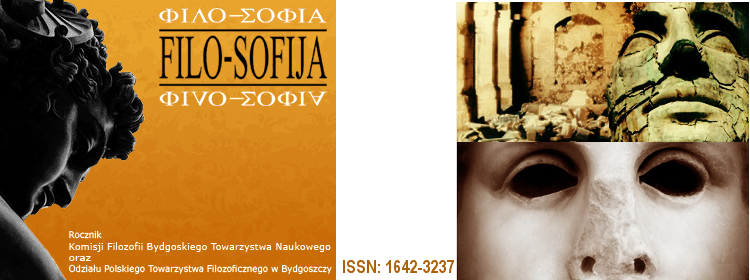Kulturoznawcza archeologia i prehistoria „kontynentu sztuki”
Abstract
Author: Kowalski Andrzej P.
Title: CULTURAL ARCHAEOLOGY AND PREHISTORY OF THE CONTINENT OF ART (Kulturoznawcza archeologia i prehistoria Kontynentu sztuki)
Source: Filo-Sofija
year: 2011, vol:.12, number: 2011/1, pages: 291-310
Keywords: JERZY KMITA, CULTURAL ARCHAEOLOGY, THE CONTINENT OF ART, SHAMANISTIC ORIGINS OF ART
Discipline: PHILOSOPHY
Language: POLISH
Document type: ARTICLE
Publication order reference (Primary author’s office address):
E-mail:
www:
Abstract The paper presents an attempt at application of Jerzy Kmita’s achievements in philosophy of art, aesthetics, axiology, and history of culture to the research on genesis of art. The problem of cultural genealogy of art shall be addressed in following contexts:
1. The context of the so-called ‘end of art in postmodern culture’ which manifests itself in the thesis concerning elimination of “grand narrations”, myths, and ideologies. According to J. Kmita, the art takes recourse to idea-meanings which are not ascribed to a handicraft. The meanings of superior axiological level express themselves in the art only.
2. The context of Bild-Anthropologie developed by H. Belting. Works of art are regarded here as images, especially—images of a cultural type. The accent lies here on genealogy of iconoclasm and theological discourse which uses Greek philosophical terminology. Ontology of “image as a presence” is analyzed with regard to magical realism and symbolism. Primordial and prehistoric images do not operate with signs of objects but instead they constitute objects themselves.
3. The context of structural anthropology where the art is interpreted within the horizon of mytho-logics and metaphoric-metonymical transformations. Kmita’s adjustment shows that metaphorical and metonymical meanings are indistinguishable. The art—which was ascribed a classificatory meaning—provided also socio-morphic categories. Totemic signs were more appreciated than totems themselves. It shows that the art transcends the reality which itself becomes a subject of the image.
4. The context of shamanistic origins of art. This conception universalizes results of neuropsychological research. Trance-practices are considered here as the origin of cave painting which presents a scheme of shamanistic visions. However, in folk cultures not all imaginary objects originate from trance-experience and the acceptance of their reality does not presuppose sensory deprivations (which is one of ethnological arguments showing limits of such interpretation).
Title: CULTURAL ARCHAEOLOGY AND PREHISTORY OF THE CONTINENT OF ART (Kulturoznawcza archeologia i prehistoria Kontynentu sztuki)
Source: Filo-Sofija
year: 2011, vol:.12, number: 2011/1, pages: 291-310
Keywords: JERZY KMITA, CULTURAL ARCHAEOLOGY, THE CONTINENT OF ART, SHAMANISTIC ORIGINS OF ART
Discipline: PHILOSOPHY
Language: POLISH
Document type: ARTICLE
Publication order reference (Primary author’s office address):
E-mail:
www:
Abstract The paper presents an attempt at application of Jerzy Kmita’s achievements in philosophy of art, aesthetics, axiology, and history of culture to the research on genesis of art. The problem of cultural genealogy of art shall be addressed in following contexts:
1. The context of the so-called ‘end of art in postmodern culture’ which manifests itself in the thesis concerning elimination of “grand narrations”, myths, and ideologies. According to J. Kmita, the art takes recourse to idea-meanings which are not ascribed to a handicraft. The meanings of superior axiological level express themselves in the art only.
2. The context of Bild-Anthropologie developed by H. Belting. Works of art are regarded here as images, especially—images of a cultural type. The accent lies here on genealogy of iconoclasm and theological discourse which uses Greek philosophical terminology. Ontology of “image as a presence” is analyzed with regard to magical realism and symbolism. Primordial and prehistoric images do not operate with signs of objects but instead they constitute objects themselves.
3. The context of structural anthropology where the art is interpreted within the horizon of mytho-logics and metaphoric-metonymical transformations. Kmita’s adjustment shows that metaphorical and metonymical meanings are indistinguishable. The art—which was ascribed a classificatory meaning—provided also socio-morphic categories. Totemic signs were more appreciated than totems themselves. It shows that the art transcends the reality which itself becomes a subject of the image.
4. The context of shamanistic origins of art. This conception universalizes results of neuropsychological research. Trance-practices are considered here as the origin of cave painting which presents a scheme of shamanistic visions. However, in folk cultures not all imaginary objects originate from trance-experience and the acceptance of their reality does not presuppose sensory deprivations (which is one of ethnological arguments showing limits of such interpretation).
Pełny tekst:
PDFAdministracja Cytowania | Strony czasopism
